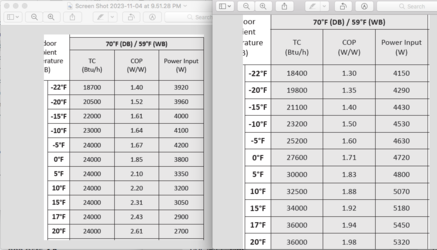I have been starting to research heat pump replacements. I currently have an old York 2ton and have been looking to upgrade to something more efficient. Being quite old it works well down to about 23F where it starts to struggle and kicks in the backup resistive heat at which time I turn it off and fire up the wood stove. This worked well when my wife was stay at home with kids and I wfh due to covid. Moved start of covid. Now that she is going back to work and I'm getting pressured to start going into the office I'm feeling it would be nice to have a more efficient heat source when not home durning the days and away for christmas etc.
I have had an energy audit done and said the heat load is 10.57kw which is about 36k btu. House is 1200sf with a finished spray foamed basement of another 1200 sf. 2400sq total and 36k btu heating load sounds possible but basements don't seem to have the same heating loads and have replaced old windows with triple glaze and will be doing additional attic blown in insulation.
Of the 8 quotes almost all of them are recommending a 3ton but not sure if my ducts will support it. I have 14 registers fed with 5" round ducts off the trunk. Given each 5" round duct is good for 5cfm that puts me around 700 cfm. The cfm of the 3t air handlers is around 1200cfm and worried about static pressure issues but really all the quotes were just sales men and no testing done. House is a bungalo with the supply truck running down center of house with the 5" rounds coming off of it to each of the rooms. Only 4 supply in the entire basement.
Don't want to pay premium for the Fujitsu or Mitsubishi so primary quotes I'm considering now is the following.
Daikin 3T DZ6VSA361E/DFVE42CP1400, The DZ6VS appears to have better cold weather then the DZ17 but it also comes with a 3.5 ton blower.
Gree Flex 2/3T with either 2 or 3 ton inside coil/air handler. Out door unit is the same.
Midea 2.5Ton runs about same power in cold weather as the Daikin 3T
Midea 3T
What would be some recommended next steps? Verify what my existing duct work would support? No idea of existing CFM but the registers close to air handlier blow like crazy which is on one end of house but other end of house don't feel much movement thru them.
I have had an energy audit done and said the heat load is 10.57kw which is about 36k btu. House is 1200sf with a finished spray foamed basement of another 1200 sf. 2400sq total and 36k btu heating load sounds possible but basements don't seem to have the same heating loads and have replaced old windows with triple glaze and will be doing additional attic blown in insulation.
Of the 8 quotes almost all of them are recommending a 3ton but not sure if my ducts will support it. I have 14 registers fed with 5" round ducts off the trunk. Given each 5" round duct is good for 5cfm that puts me around 700 cfm. The cfm of the 3t air handlers is around 1200cfm and worried about static pressure issues but really all the quotes were just sales men and no testing done. House is a bungalo with the supply truck running down center of house with the 5" rounds coming off of it to each of the rooms. Only 4 supply in the entire basement.
Don't want to pay premium for the Fujitsu or Mitsubishi so primary quotes I'm considering now is the following.
Daikin 3T DZ6VSA361E/DFVE42CP1400, The DZ6VS appears to have better cold weather then the DZ17 but it also comes with a 3.5 ton blower.
Gree Flex 2/3T with either 2 or 3 ton inside coil/air handler. Out door unit is the same.
Midea 2.5Ton runs about same power in cold weather as the Daikin 3T
Midea 3T
What would be some recommended next steps? Verify what my existing duct work would support? No idea of existing CFM but the registers close to air handlier blow like crazy which is on one end of house but other end of house don't feel much movement thru them.


